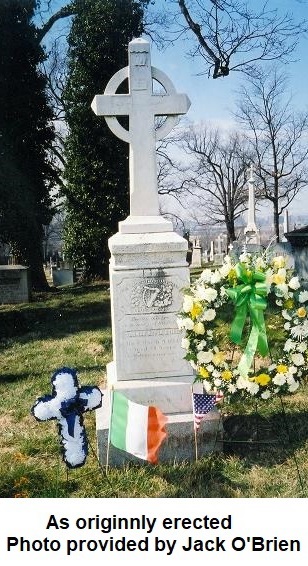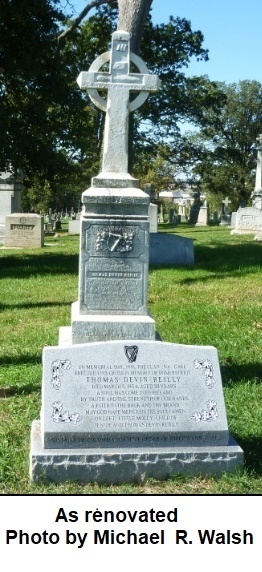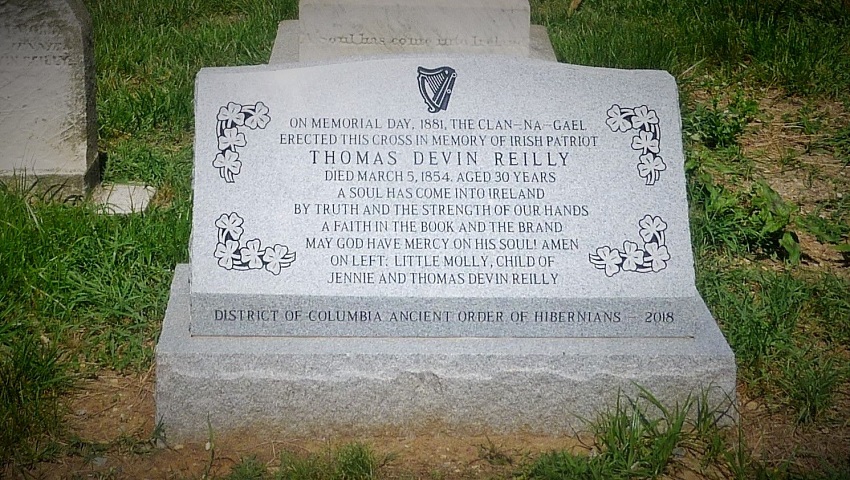Thomas Devin Reilly (1824 - 1854)
Irish Republican, Writer, Young Ireland Rising of 1848 participant, Political exile.
 The honor roll of Irish
patriots who over the centuries have struggled, fought,
suffered and died for the freedom and independence of
Ireland and the dignity of its citizens is long and
legendary. The near forgotten final resting place of one
name on that honored roll, is a wooded hillside in the Mount
Olivet Catholic Cemetery in the Brentwood section of
northeast Washington D.C.
The honor roll of Irish
patriots who over the centuries have struggled, fought,
suffered and died for the freedom and independence of
Ireland and the dignity of its citizens is long and
legendary. The near forgotten final resting place of one
name on that honored roll, is a wooded hillside in the Mount
Olivet Catholic Cemetery in the Brentwood section of
northeast Washington D.C.
Resting there along with his wife and infant daughter, under a unique and weather beaten Irish Celtic Cross monument is Thomas Devin Reilly, a prominent leader, writer and spokesman of the Young Ireland movement of the mid 1840’s. Reilly fled Ireland for America in late 1848, at the height of the famine, while on bail following his arrest by the British. He died suddenly five years later at age 30 of a stroke on March 5, 1854 while working for the administration of U.S. President Franklin Pierce.
The name “Young Irelanders” was given to a group of young Irish intellectuals and writers, who broke away from the repeal movement of Daniel O’Connell to advocate more radical and militant action to free Ireland from what they viewed as the yoke of British oppression. All across Europe in the latter half of the 1840’s, the winds of nationalism and class struggle were leading to widespread social unrest and Ireland was no exception.
The speeches, newspaper articles, writings and actions of this group of young militants have carried forward to the present time to form much of the basis for Irish nationalism. To students of Irish history, their names are well known; Gavan Duffy, Thomas Davis, Smith O’Brien, John Mitchel, John Martin, Fintan Lalor, Terrance Bellew McManus, Thomas Francis Meagher and not least, Thomas Devin Reilly.
Born in County Monaghan, and educated at Trinity college Dublin, Reilly first achieved prominence as a writer for The Nation newspaper shortly before the outbreak of the famine. When under Thomas Davis The Nation was outlawed by the British, Reilly joined with his good friend and mentor John Mitchel to write articles for The United Irishman and later following the arrest of Mitchel by the British authorities, he and John Martin founded and edited the Irish Felon newspaper. All of these newspapers, as is clearly evident from their very names, increasingly fanned the fires of Irish nationalism and sowed the seeds of revolution and unrest against the English authorities in a way not seen since the rebellion of 1798.
On all of the papers for which he wrote for, Reilly was uniquely known for preaching open rebellion, including the use of arms against the British. Mitchell a renowned figure in Irish and American history for his militant actions against the British, and his support of the south during the Civil War in America, said Reilly “had red lightning in his blood.”
Throughout his short life, Reilly was a believer in and a champion of the working class and tenant farmer citizens. At the near height of the famine he and several others openly advocated as the first duty of the people to refusal to pay rents, to retain their crops to feed their own families and to break up of bridges and railroad lines to prevent the removal of food from the counties. He insisted upon the right of the working class to work out its own salvation by force of arms if necessary. His grew impatient with the endless parliamentary declarations, never ending talk, disjointed action, and the deepening famine, but nevertheless maintained his faith in the common man. Reilly’s aggressive stance can be seen in the quote below:
“If the landlords of Ireland make their existence incompatible with the lives of the people, every one of us must choose either to fall with the landlords or live with the people. When it comes to that you can take no medium course. You cannot continue silent and inactive. You cannot stand between parties. They will crush you in the collision.”
While writing and preaching rebellion in the Irish Felon newspaper, Reilly was arrested by the British in 1848. He was released on bail however, and actively participated in the aborted uprising in Ireland of late July, 1848, which culminated in the” fiasco”’ of a small band of hungry men and even women and children confronting British troops at the widow McCormack’s house in Ballingarry, County Tipperary. Hiding in the hills southwest of Dublin, and evading the British, who were arresting and imprisoning all the leaders of the rebellion, Reilly moved to the north of Ireland and eventually was able to escape to America.
He settled initially in New York City, but in 1850 moved to Boston to administer one of the first labor publications in America, the Protective Union, a labor journal of the printers. It was in Boston that he met and later married Jennie Miller, a native of Enniskillen, who is also buried with him at Mt. Olivet. Reilly at this time, began contributing articles to such publications as the Democratic Review and the Boston Post. The newspaper articles achieved significant notice in the Northeast and were considered helpful to the election campaign for U.S. President of Democratic candidate Franklin Pierce of nearby New Hampshire, who was opposed by the Whig opponent Winfield Scott.
Pierce, a Democrat, subsequently became a personal friend of Reilly and provided him with a patronage position in the U.S. Land Office in Washington D.C. following his victory in the 1852 presidential election. Following his move to Washington D.C. in September of 1853 at the age of 29, Reilly also began writing for the Pierce administration’s main news organ vehicle The Union. In less than six months however, just as he was beginning to achieve financial stability and personal recognition in his adopted country, he would be dead, after an attack of apoplexy, to which he was apparently prone, having had an earlier severe seizure when he was a teenager. His obituary in the Tuesday, March 7, 1854 edition of the New York Daily News stated:
“In Mr. Reilly’s early demise the Irish cause has lost an able soldier and the aid of a brilliant intellect.”
Although Reilly and the Young Irelanders have been accused of plunging Ireland into an unplanned and totally unsuccessful revolt in 1848, history shows that they reawakened patriotism in Ireland and laid the foundation for the Irish Revolutionary Brotherhood, who a decade later would begin the next chapter in Ireland’s long struggle for independence. The seeds of nationalism which they planted in the mid 1840’s did not immediately flower, in large part because of the devastating famine, but in due time would later bear fruit.
The 1848 insurrection failed for a number of reasons, chiefly due to a lack of widespread support among the peasantry, in large part because of the hunger, misery and sickness brought on by the devastating famine. A lack of resolve and indecision on the part of some leaders like Smith O’Brien and Father Kenyon, coupled with the active opposition of the majority of the clergy and a lack of arms were just additional factors that doomed the disorganized revolt. In the final days of July, just before the British army snuffed out the revolt, Reilly, militant to the end and realizing the futility of the revolt, declared he would sooner be shot than witness another like this day’s exhibition, boys and girls and unarmed men, neither capable of offering resistance nor of affording protection.
Upon his death, Thomas Devin Reilly was initially buried at St. Matthew’s cemetery in Washington. Subsequently, many prominent Irish-American individuals contributed donations to the cause of erecting a lasting memorial in Reilly’s honor and for the care of his young wife and infant child. They included among others, fellow Irish nationalist, Thomas Francis Meagher, future leader of the famous northern Irish Brigade in the civil war. Other supporters were future Union Generals, Daniel Sickles and James Shields, as well as a future Vice President, John Breckinridge.
When St. Matthew’s cemetery was closed and Mt. Olivet opened in 1862, his remains were re-interred there. Principally due to the time needed to raise sufficient money and arrange for the memorial, as well as the disruption of the Civil War, it was not until Decoration Day (Memorial Day) in 1881, that a very unique and distinguished Celtic Cross monument was unveiled at Reilly’s gravesite to commemorate his life by the Clan na Gael Society. The Clan na Gael, with branches in major east coast cities, was a secret Irish-American organization working to raise funds and plan activities on behalf of establishing a free Ireland, independent in all respects from England.
It was estimated that over five thousand people, including Reilly’s wife Jennie, attended the unveiling and dedication of the monument. The pastor of St. Matthew’s Catholic church, Reverend Father Boyle gave a blessing to the monument following which he also gave the principle address at the ceremony, reflecting on the life of Thomas Devin Reilly and his lasting legacy.
On Decoration Day 1881, the Clan na Gael erected this cross in memory of the patriot Thomas Devin Reilly, died March 5, 1854, aged 30 years. May God have mercy on his soul. Amen.”
The Celtic Cross monument in tribute to Reilly is made of Italian marble on a granite base and stands approximately twelve feet tall. It is unique both for its design and the Celtic inscriptions. Many of the markings are difficult or impossible to read however, as the ravages of time and weather have taken their toll. It has been said that monuments to the memory of departed heroes are the silent footprints of history upon the pages of time. This is certainly true at the Reilly gravesite.
On the front of the lower base of the monument is the inscription “ A SOUL HAS COME INTO IRELAND,” meaning that Reilly has gone home. The central block above this is ornamented with the figure of a harp surrounded by shamrocks, with the following inscription in English, which on the opposite side is also inscribed in Gaelic:
On the other two sides of the lower base appear the Fenian motto, also in English and Gaelic, “BY TRUTH AND THE STRENGTH OF OUR HANDS.” On the four sides of the monument cap beneath the cross are depicted in shields the arms of Irelands four provinces, the Harp of Leinster, the Hand and Dagger of Connaught, the Three Crowns of Munster and the Red Hand of Ulster. These however are nearly invisible due to the ravages of time.
The upper portion of the cross depicts in relief, the sunburst as emblem of all Ireland.
A most unique feature of the monument, which appears in relief on the lower center portion of the cross is a book with a shamrock on the cover representing the history of Ireland. Beneath the book, is an ancient Irish sword/dagger, with the inscription: “ A FAITH IN THE BOOK AND THE BRAND.” (The word brand is a word formerly used to sometimes refer to a sword.)
On the left side of the base is an inscription to Reilly’s wife Jennie, who died eleven years later on July 30, 1892 and is also interred at the site. Near the foot of the grave several feet away, is a flat weather beaten marble slab that marks the grave of “little Mollie,” the only child of Devin Reilly, who died shortly after his death. The base of the headstone for Mollie has been lost to time.
The artist for this unique piece of Irish history was Thomas Heany, a stonecutter from County Longford in Ireland. The memorial is located approximately 50 yards north of the main administrative offices at Mount Olivet cemetery, close to the top of a hill, directly across from the burial lot of the Dominican Fathers.
Contributed by: John B. Haltigan
cemetery
Name: Mount Olivet Cemetery
ADDRESS: 1300 Bladensburg Road Northeast, Washington,
DC 20002
HEADSTONE




